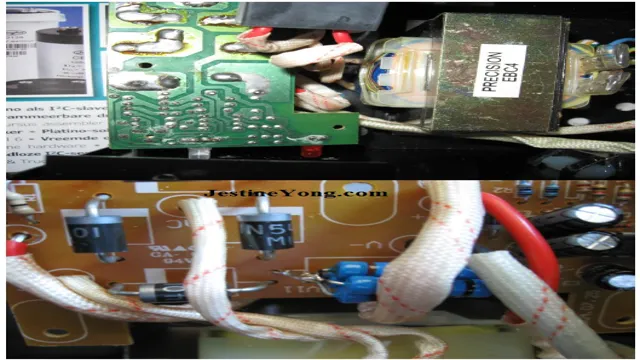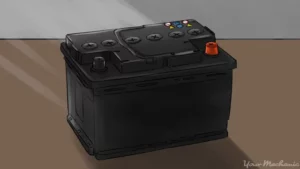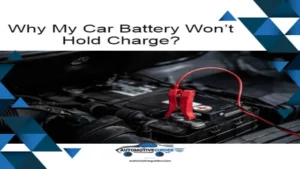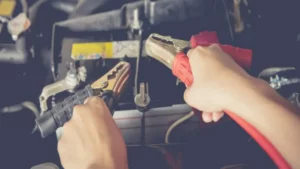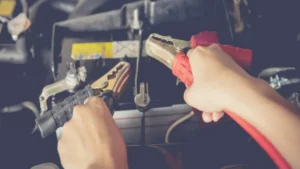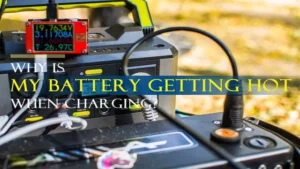As car owners, we have all experienced the frustration of a dead battery. But what happens when your car battery charger fails to do its job? Don’t worry, fixing a car battery charger can be easier than you think. In this step-by-step guide, we will walk you through the process of fixing your car battery charger so that you can get back on the road in no time.
First things first, before attempting to fix your car battery charger, it is essential to understand how it works. A car battery charger takes in electricity from an outlet and uses it to charge your car battery. The charger then monitors the battery level and automatically switches off once the battery is fully charged.
Now, let’s get started with the actual fixing process. The first step is to check the power cord and make sure it is plugged in correctly. If the cord is loose, try tightening it or replacing it if it is damaged.
Next, check the battery terminals for corrosion or damage. If you see any corrosion, use a wire brush to clean the terminals. If the terminals are damaged, replace them.
If the above steps don’t solve the problem, it could be an issue with the charger’s internal components. In this case, it may be best to take it to a professional or replace it altogether. In conclusion, fixing a car battery charger is a relatively simple process that can save you time and money.
By following these simple steps, you can diagnose the issue and get back on the road without having to worry about a dead battery.
Identify the problem
If you’re struggling with a faulty car battery charger, identifying the problem is the first step towards finding a solution. Common issues with chargers include loose connections, damaged cables, or a dead battery. Before attempting any repairs, it’s important to ensure that the charger is unplugged from the wall and disconnected from the car battery.
Once you’ve identified the problem, you can begin troubleshooting. In some cases, a simple fix such as tightening a loose cable may be all that’s needed. However, if the battery is completely dead or the charger is beyond repair, it may be time to invest in a new one.
By taking the time to identify the issue and work through potential solutions, you can get back on the road with a reliable battery charger.
Check the fuse
When faced with an electrical issue, the first thing you should do is check the fuse. A blown fuse is often the culminating factor behind an electrical outage or malfunction. When you have identified an electrical problem, the next thing to do is locate the electrical panel, which is usually located in your basement or garage.
Once you’ve found it, open the panel, and inspect the fuses. A failed fuse can be recognized by the broken metal wire inside it, which can be visible through the glass window in the fuse. In case you can’t see the wire, you can test it with a multimeter.
If you’ve identified a blown fuse, replace it with one that has the same amperage rating. Remember not to replace a blown fuse with one that has a higher amperage rating as it could lead to a fire. In conclusion, checking the fuse is an easy yet essential step in troubleshooting electrical issues, and it could prevent you from calling an electrician unnecessarily.
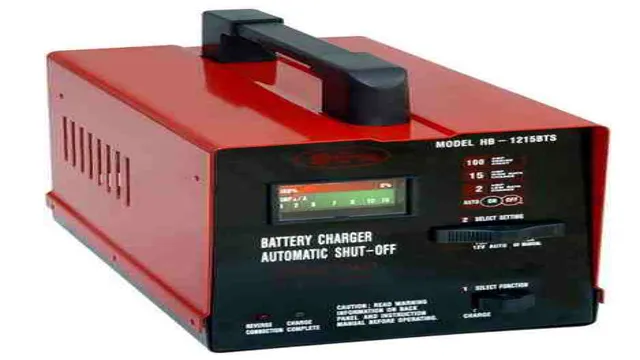
Check the cord and connections
When your electronic device is not functioning as it should, one of the first things to check is the cord and connections. It may sound obvious, but sometimes it’s easy to overlook. The problem could be as simple as not plugging something in all the way or a cord that has become loose over time.
Start by examining the cord for any damage such as fraying or cuts. If there is visible damage, it’s time to replace the cord. Next, ensure that the cord is securely connected to both the device and the power source.
Sometimes cords can become loose or disconnected without us realizing it. Additionally, check for any dirt or debris that may be interfering with the connection. A clean and properly connected cord can make all the difference in the performance of your device.
So, before you start troubleshooting other issues, make sure to double-check the cord and connections.
Check the battery clamps
Checking the battery clamps is an essential part of maintaining your vehicle’s battery health. If your car fails to start, it could be a sign of a weak battery or a loose connection at the battery clamps. Loose or corroded connections can decrease the battery’s power output, which can lead to starting problems.
An easy way to identify the problem is to visually inspect the battery clamps for signs of corrosion or build-up. If there is corrosion, clean the area thoroughly with a solution of baking soda and water. Always remember to disconnect the negative clamp first before the positive clamp to prevent sparks and possible shock.
Once you have cleaned and tightened the clamps, try starting the car to see if the problem has been resolved. By regularly checking your battery clamps, you can ensure a longer battery life and prevent a breakdown in the middle of nowhere.
Replace any faulty parts
If you need to fix a car battery charger, one of the first things to check is whether any parts are faulty. Start by inspecting the cable and plug to ensure they are not damaged or frayed. If they are, consider replacing them with new ones.
Check the fuse and replace it if necessary. It’s also important to examine the battery terminals for any signs of corrosion or damage. If you notice any issues, try cleaning them with a wire brush or sandpaper.
Finally, check the internal components of the charger, such as the transformer and rectifier, for any signs of damage or wear and tear. If you identify any faulty parts, replace them with new ones to ensure your charger is working correctly. Remember to always double-check your work and safety precautions before plugging in your charger.
With a few simple checks and replacements, you can have your car battery charger back up and running in no time.
Replace the fuse
If you’re experiencing problems with your electronic device, a faulty fuse is a possibility. Replacing the fuse is easy and can resolve your issue. First, you need to unplug the device from its power source to avoid electrocution.
Then, locate the fuse, which could either be attached to the power cable or inside the device. Check the fuse for any signs of damage, such as burn marks or a broken filament. If the fuse is damaged, replace it with a new one that has the same rating.
Remember to use the right type of fuse to avoid compromising your device’s operation. In some cases, a faulty fuse could indicate deeper issues with your device. If you replace the fuse, and your device still fails to work properly, you likely need to have an expert diagnose and repair it.
Don’t let a faulty fuse keep you from enjoying your device; take action and get it fixed.
Replace the cord and connections
It’s not uncommon for cords and connections to wear out over time, which can lead to all sorts of problems with your devices. If you’re experiencing issues like poor sound quality, connectivity problems, or overall performance issues, the first thing you should consider doing is replacing any faulty parts. This might include the cord itself, as well as any connectors or adapters that are part of the system.
Depending on the device in question, this can be a relatively simple process or something that requires a bit more expertise. However, with the right tools and knowledge, most people should be able to replace a cord or connection without too much trouble. By doing so, you can restore your device to full functionality and enjoy all the features it has to offer without any annoying glitches or problems.
So if you suspect that your device is having issues due to a faulty cord or connection, don’t hesitate to take action and get it fixed ASAP.
Replace the battery clamps
If you’re experiencing issues with your battery clamps, it may be time for a replacement. Faulty clamps can lead to a weak or inconsistent electrical connection, which can cause issues in starting your vehicle or even damage your battery over time. To replace the clamps, first, use a wrench to remove the nuts holding the clamp in place.
Then, remove the old clamp and any corroded or damaged parts. Finally, attach the new clamp and tighten the nuts securely. By replacing any faulty parts promptly, you can keep your vehicle running smoothly and prevent further damage.
Don’t hesitate to seek the help of a professional if you’re unsure of how to proceed. Your vehicle and safety are too important to take chances with.
Test the charger
So, you suspect that your car battery charger isn’t working properly. The first step in figuring out how to fix a car battery charger is to test the charger itself. You can do this by using a multimeter to check the voltage output.
Start by turning the charger on, then set the multimeter to “DC volts” and connect the red lead to the positive output on the charger and the black lead to the negative output. The multimeter should show a voltage output that corresponds to the rating of the charger. If the voltage is less than it should be, the charger might need repair or replacement.
If the charger is working properly, the issue could be with the battery itself or the connections between the battery and the charger. Testing the charger is the first step in identifying the problem and finding a solution.
Connect the charger to a battery and turn it on
If you’ve recently purchased a battery charger, it’s important to ensure that it works well before you start using it regularly. To test the charger, you’ll need to connect it to a battery and turn it on. It’s ideal to use a battery that’s close in size and capacity to the one you plan on using the charger for.
Before connecting the battery, make sure to read the charger’s instructions thoroughly, as different models may have specific requirements for how to hook up the battery. Once you’ve connected the battery, turn on the charger and make sure that it’s providing a steady flow of energy to the battery. You can use a multimeter or voltmeter to measure the output voltage and current of the charger.
If the readings are within the range specified by the charger’s manual, then it’s likely that the charger is working well. It’s always a good idea to test the charger periodically to ensure that it continues to work as intended. With a functional battery charger, you can rest easy knowing that your batteries will always be ready when you need them.
Check the charging voltage with a multimeter
One of the best ways to check if your phone’s charger is working properly is to test its charging voltage using a multimeter. It’s a simple process that can help you determine if your charger is supplying the right amount of power to your device. First, make sure your phone is unplugged from the charger and turned off.
Then, plug in your charger and wait for a few seconds. Next, turn on your multimeter and set it to measure DC voltage. Connect the red lead to the positive terminal of the charger and the black lead to the negative terminal.
Your multimeter should now display the charging voltage. Ideally, a standard USB charger should supply around 5 volts, so if your reading is significantly lower or higher than that, it might be time to consider getting a new charger. By testing your charger’s charging voltage, you can ensure that your phone gets the power it needs to function properly, and that your charger isn’t causing any damage to your device.
Tips for maintaining a car battery charger
Car battery chargers are essential for prolonging the life of your car battery and avoiding the inconvenience of a dead battery. However, even the best quality chargers are subject to wear and tear over time, and it’s essential to keep them in top working condition for optimal performance. One of the most important tips for maintaining your car battery charger is to keep it clean and dry.
Moisture and dust can accumulate on the charging terminals, leading to corrosion and a decreased charging capacity. Additionally, it’s crucial to check the charger’s cables and wiring regularly for fraying or damage, as these issues can interfere with the charging process. If you’re wondering how to fix a car battery charger that is not working correctly, it’s always advisable to consult the manufacturer’s instructions or seek professional assistance.
With proper care and maintenance, your car battery charger should provide reliable service for many years to come.
Conclusion
In conclusion, fixing a car battery charger is not rocket science, but instead, it requires a great deal of patience, some technical skills, and the willingness to get your hands dirty. Just like a battery needs to be recharged periodically to function effectively, a charger also needs some TLC to perform optimally. So, don’t give up on your faulty charger just yet! Follow the troubleshooting techniques we’ve outlined above, and you’ll be back on the road in no time.
And who says fixing a charger can’t be fun and exciting? It’s a perfect opportunity to put your inner mechanic to work and show off your skills to your friends and family. Happy fixing!”
FAQs
What are the common problems that can occur in a car battery charger?
Some common problems that can occur in a car battery charger include a blown fuse, loose connections, or a faulty transformer.
Can a car battery charger be overcharged?
Yes, overcharging a car battery can cause damage to the battery and the charger. It’s important to follow the manufacturer’s instructions and monitor the charging process.
How long does it take to charge a car battery with a charger?
The time it takes to charge a car battery with a charger can vary depending on the charger’s output and the battery’s capacity. Generally, it can take anywhere from 30 minutes to several hours.
How can I tell if my car battery charger is working properly?
You can tell if your car battery charger is working properly by checking the voltage output with a multimeter and monitoring the battery’s charging progress.
What should I do if my car battery charger is not working?
If your car battery charger is not working, you should check the power source, the connections, the settings, and the safety features. If you cannot identify the problem, it may be necessary to replace the charger.
How can I maintain my car battery charger for optimal performance?
To maintain your car battery charger for optimal performance, you should clean and store it properly, avoid overcharging or undercharging, and follow the manufacturer’s instructions for usage and maintenance.
Can I use a car battery charger to jump-start my car?
While some car battery chargers may have a jump-start feature, it’s generally recommended to use specialized jump starters for safety and optimal performance.
